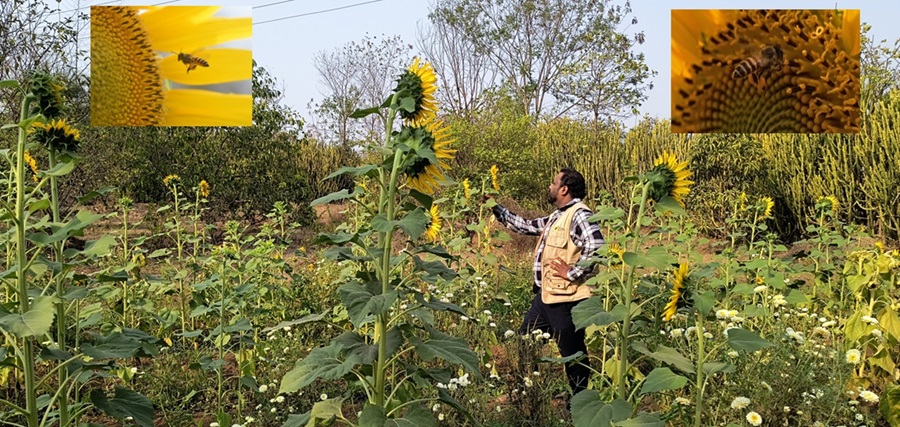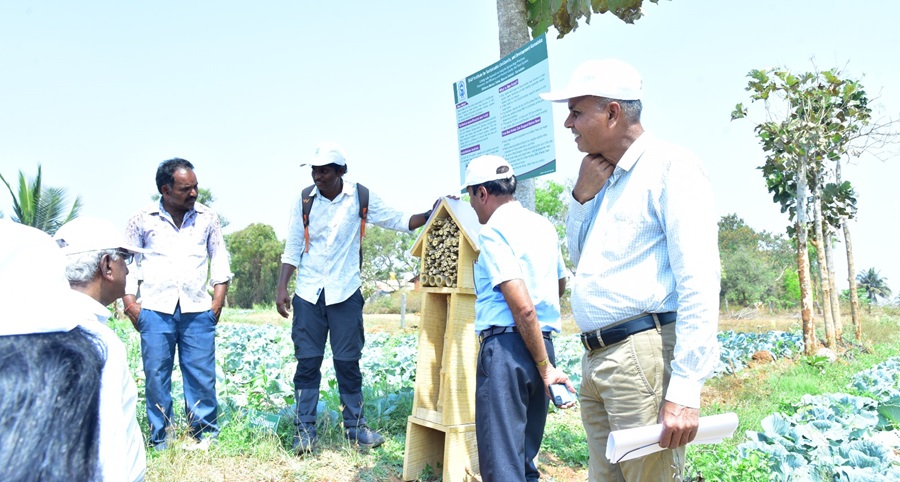
The word insect derived from the Latin word ‘insectum’, meaning “cut into sections,” plays a crucial role in our ecosystem, particularly in agriculture and forest ecosystems. Insects have permeated human culture since ancient times, evident from depictions of honey bees in caves, Egyptian hieroglyphs and references of beetles and lac insects in the Mahabharata. These tiny creatures play multiple roles, serving as pollinators, predators and as a source of livelihood. Bees, in particular, stand out for their role in pollination and honey production. Traditional honey harvesting methods which are destructive, are being replaced by scientific approaches, ensuring sustainable practices that benefit both bees and beekeepers.
There are many saints in India of which almost all preach that every life on earth is precious and needs to be conserved and lived with. Saint Tukaram Maharaj, a saint had said “Wruksh walli amha soyari,” meaning the importance of co-existence of flora and fauna with human interventions and more diverse the nature, more healthier is the environment. Intensification of flora or crops leads to decrease in diversity. Decrease in diversity leads to loss of a healthy environment.
BAIF documented 700 plus species of lepidoptera insect species from different parts of the country and mostly from Maharashtra, Karnataka and Odisha states i.e. a few areas of Western Ghats and a few areas of Eastern Ghats. A few species were reported 100 years ago. 56 lepidopteran species associated with Alstonia scholaris were documented.

Insect documentation during the British era in India included most of the insect species and the first entomologist post was started in India. Many volumes are available for reference studies. In the year 1758, Carl Linnaeus published “Systema Nature”, J.C Fabricus classified the insect into 13 orders, J.G. Koenig published a special account of termites of Thanjavur district, Dr. Kerr published an account of lac insect and lac insect genus named kerria lacca on his name.
These insects are extremely useful in creating a healthier environment. They are many types of pollinators, predators and parasites. Insect is useful for livelihood and they provide various services with pollination and natural control of insect being their most known services.
The first insect which comes in one’s mind is butterfly. Second, bees. Bees are mostly honey producing and non-honey producing, social and Eusocial wasps. Apis dorsata, Apis cerana indica, Apis florea are commonly seen in the field. Stingless bees are also one of the honey producing bees two species of which are reported from India. Stingless bees are mostly small bees which visit diversified flowers at a single time. They collect nectar and pollen. In a few parts, such bees are reared by farmers. They are mostly found in crevices of old houses and trees. Agricultural crops like brinjal and cilli cucumber are different gourds pollinated by Apis dorsata, Apis cerana indica, Apis florea,Tetragonula iridipennis, Xylocopa sp., Xyalocopa amethystina, Amegilla sp. Nomia westwoodi etc. Our study shows that Apis cerana indica visits more diverse crops and plants. Xyalocpa Sp. are also important in agriculture.

Apis dorsata – Commonly known as rock bee, this species is aggressive in nature having sting and attacks more serious than other bees. A few people are traditional honey harvesters and in many areas, they use smoke in the night and cut whole honey hives which is a very unsafe practice.
BAIF is teaching such honey bee practitioners a scientific honey harvesting method, as the hive contains a special structure where the honey is kept and can be harvested without damaging the entire colony. This practice will increase the colonies and population of Apis dorsata. As in scientifically honey harvesting practice, the hive is kept intact in the same position and only the stored honey is harvested and in due course of time, it is again filled by bees. The eggs and broods are safe in the colony.
Endemic plant species, such as Smithia purpurea and Senecio bombayensis, form crucial habitats for insects, highlighting the importance of conserving these unique ecosystems. However, modern agricultural practices, including use of herbicide cause loss of these endemic species. The intricate relationship between insects and farming communities underscores the need for sustainable agricultural practices which promote biodiversity.
Soil moisture is the most important parameter for increasing floral diversity and decrease in moisture results in loss of floral diversity. Soil moisture conservation is the most important criteria for a healthier environment. Under ecological restoration activities, soil moisture retention is the major task performed by BAIF.

However, modern agricultural practices marked by intensive pesticide use are more harmful to nature for insect populations. BAIF is working on holistic approaches that harness natural pest control mechanisms and enhance pollination services. Crop combination and natural control of pest insect enhance pollination services.
Sericulture, lac cultivation, honey bee keeping are examples of how insects contribute to livelihood and environmental sustainability. Sericulture is a homestead activity in many parts of the country but lac cultivation is possible only in some parts of the country such as subtropical regions with availability of host plants like Schleichera oleosa, Ziziphus mauritiana and Butea monosperma which result in successful lac cultivation. Jharkhand, Chhattisgarh, Odisha, Maharashtra, Madhya Pradesh and Bihar are the major lac producing states. The intricate ecosystems of lac cultivation with predators and parasites coexisting, underscore the delicate balance of nature.
In Central India, farmers from Vidarbha region are involved in lac cultivation on Butea monosperma (ber), and Schleichera oleosa (kusum). Female lac insect has a greater role in lac cultivation than the male lac insect. Lac cultivation is also a micro ecosystem with predator and parasite insects. These predators also have some other parasites such as Bracon greeni Pristomerus sulci and Apanteles sp. etc found in lac cultivation.

While tussar silk, muga silk and other types of silk are generally produced in the Southern part of India and Northeast, in Maharashtra. Tussar silk production is in an open environment and sericulture, the Gynandromorph is also found in tussar silk. Lepidopterous insect voraciously feeds on the host plants and casts cocoons which are used in silk production. Xanthopimpla punctata is the parasite for tasar silk. She lays eggs over larva which are mature enough. These mature larvae make cocoons and safely comes inside the developed cocoons and starts to grow inside the cocoons, feeds on the pupa inside and the adult Xanthopimpla sp. comes out of tussar silk cocoon. This Xanthopimpla sp. is the most important parasite in agriculture which controls many lepidopterous insects from the cucurbits field. by parasitising the larvae. BAIF documented gynandromorph from Tasar moths.
Farmers are adopting innovative practices like creating flower strips along bunds, hedge rows of long-term nectar source crops and a few plants like Moringa oleifera, Citrus sp., Bergera koenigii, Pongamia pinnata, shrubs such as Celosia argentea and other nectar producing and attractive coloured flowers to attract pollinators and beneficial insects and birds. These pollinators stay for a longer duration in the field as they also require food, water and shelter. Farmers are keeping soil moisture, dry wooden logs for buildings or constructing nests inside dry woods. Diversified cropping patterns not only enhance pollination but also a healthier agro-ecosystem.
Many solitary bees and wasps make houses in dry wooden cavities, collecting pollen and nectar to feed their young ones or larvae. These insects are pollinating different crops in the agriculture field. They are sowing crops in a 100–200-meter area for food production. Many species are making nest in the dry wood. Bee hotels can also be used by farmers to attract solitary bees and wasps to make nests in the agriculture field.

Diversified cropping pattern adaptation leads to a healthier environment and as a source of nutritive food. While maintaining the diverse cropping pattern, a few patches of strips of colourful flowers like yellow, orange and violet blue are used. These flowers attract most of the pollinators with nectar, Crotalaria juncea and other Crotalaria sp. also attracts more pollinators in the field by providing nectar and pollen, for maintaining the pollinators in the agriculture filed for longer duration. Such crops are useful while these have their own benefits rather than pollinators support. Based on traditional knowledge, farmers were earlier maintaining a diverse cropping pattern in which multiple crops were cultivated as perennial crops or long duration crops such as oil seed crops like Linum usitatissimum (Flax seed), Foeniculum sp.(Fennel seed), Cuminum Sp. (cumin seeds), Carthamus tinctorius L (Safflower), Brassica sp. (Mustard), Seasamum indicumL., Cajanus cajan, etc. These are the most useful floral diversity combinations. With different crops, this flora attracts the pollinator as well as predators. This flora produces nectar and pollen grains, for longer duration and many of these diverse crops have medicinal properties. Pollinators are important in agriculture as the pollinators mediate pollination, increase the quantity as well as quality of food as revealed by many studies.
BAIF developed butterfly gardens initiatives to serve as educational hubs, with focus on awareness about the vital role insects play in our ecosystem. Knowledge sharing with the new generation results in multiple host plants planted in such a way that the butterflies can be attracted towards it for laying eggs over larval host plant and nectar host plants. The butterfly population lay eggs and start the life cycle in the garden, egg-larva, pupa, and adult. These butterfly gardens are playing a major role in educating and enhancing the awareness of children and the community.

As indicators of environmental quality, insects offer valuable insights into the state of our ecosystems, water availability and soil moisture as they are mostly dependent on the floral diversity. Some insects are host specific, monophagous, some are polyphagous and a few flora are grown only in particular places and particular temperature and humidity. Hence, the insect is also growing over flora and having a bearing on the quality of environment.
In some regions, insects even find their way onto our plates, with tribal communities incorporating them into their diets. This practice highlights the symbiotic relationship between humans and insects . Edible insects exist in a few areas in India where people use insects as food – ants’ eggs, wasp nests and broods of honey bees.


I just could not depart your web site prior to suggesting that I really loved the usual info an individual supply in your visitors Is gonna be back regularly to check up on new posts
Thank you for the auspicious writeup It in fact was a amusement account it Look advanced to far added agreeable from you However how can we communicate
Thank you for the good writeup It in fact was a amusement account it Look advanced to far added agreeable from you However how could we communicate
Fantastic beat I would like to apprentice while you amend your web site how could i subscribe for a blog site The account helped me a acceptable deal I had been a little bit acquainted of this your broadcast offered bright clear concept
I do trust all the ideas youve presented in your post They are really convincing and will definitely work Nonetheless the posts are too short for newbies May just you please lengthen them a bit from next time Thank you for the post
hiI like your writing so much share we be in contact more approximately your article on AOL I need a specialist in this area to resolve my problem Maybe that is you Looking ahead to see you
Hello my loved one I want to say that this post is amazing great written and include almost all significant infos I would like to look extra posts like this
Simply desire to say your article is as surprising The clearness in your post is simply excellent and i could assume you are an expert on this subject Fine with your permission let me to grab your feed to keep up to date with forthcoming post Thanks a million and please carry on the gratifying work
Hello my loved one I want to say that this post is amazing great written and include almost all significant infos I would like to look extra posts like this